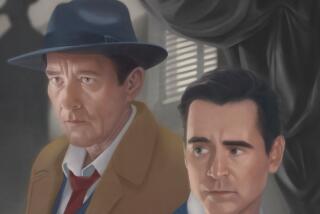When Dashiell met Raymond, or the day Hammett met Chandler
Dashiell Hammett and Raymond Chandler, the two masters of classic noir fiction, met just once. That was 78 years ago today, Jan. 11, 1936, in Los Angeles.
The occasion was the first West Coast get-together for Black Mask Magazine. A photograph taken at the end of the meal shows 10 pulp writers gathered patiently around the end of a table. Chandler and Hammett are both standing: Chandler has the pipe. Hammett, the tallest, is at the far right.
Of the 10, it was Hammett and Chandler whose work would become the most enduring. But there was no way of knowing that at the time -- while both authors contributed to Black Mask, the two were at very different places in their careers.
Hammett was the more successful, by far. He’d published his first Continental Op novel in 1929 and “The Maltese Falcon,” featuring detective Sam Spade, in 1930. “The Maltese Falcon” wasn’t yet a film, but his novel “The Thin Man” was. Released in 1934, it was a commercial and critical success. “The Thin Man” was such a hit that Hammett had been persuaded to come to Hollywood to help write the sequel.
By comparison, Chandler was a novice. He’d published a half-dozen short stories and that was it. He was much less accomplished than Hammett, and on top of that, six years older. Chandler didn’t begin writing until he was in his 40s -- and then only after getting fired from his job at an oil company.
No wonder Chandler didn’t make much of an impression on Hammett -- who, apparently, never bothered to write a word about him.
Later, of course, Hammett and Chandler would be tied together as top detective writers of their age -- or any age, for that matter. They wrote with style and created great characters. Their books translated well to film.
And indelibly, Humphrey Bogart played the iconic detectives each of them created -- Hammett’s Sam Spade in “The Maltese Falcon” and Chandler’s Philip Marlowe in “The Big Sleep.” On the page, the characters were very different; on screen, Bogart embodied them both.
Those movies were still a ways off when Chandler and Hammett met at that Black Mask event. There, Hammett made an impression on Chandler, who did write about him. In a 1949 letter to Canadian journalist Alex Barris, he said of Hammett: “He was tops. Often wonder why he quit writing after ‘The Thin Man.’ Met him once only, very nice looking tall quiet gray-haired -- fearful capacity for Scotch, seemed quite unspoiled to me.”
Four years before, Chandler had outlined his ideas about detective fiction in the Atlantic in the essay “The Simple Art of Murder.” Of Hammett, he wrote in part, “Hammett gave murder back to the kind of people that commit it for reasons, not just to provide a corpse; and with the means at hand, not with hand-wrought duelling pistols, curare, and tropical fish. He put these people down on paper as they are, and he made them talk and think in the language they customarily used for these purposes. He had style, but his audience didn’t know it, because it was in a language not supposed to be capable of such refinements.... He is said to have lacked heart, yet the story he thought most of himself is the record of a man’s devotion to a friend. He was spare, frugal, hardboiled, but he did over and over again what only the best writers can ever do at all. He wrote scenes that seemed never to have been written before.”
Which is a tremendous compliment -- even bigger than “fearful capacity for Scotch.”
ALSO:
A Spanish-speakers’ view of ‘Our America’
Amiri Baraka, activist poet and playwright, dies at 79
Authors prefer traditional publishers to self-publishing. Surprised?
Carolyn Kellogg: Join me on Twitter, Facebook and Google+
More to Read
Sign up for our Book Club newsletter
Get the latest news, events and more from the Los Angeles Times Book Club, and help us get L.A. reading and talking.
You may occasionally receive promotional content from the Los Angeles Times.








